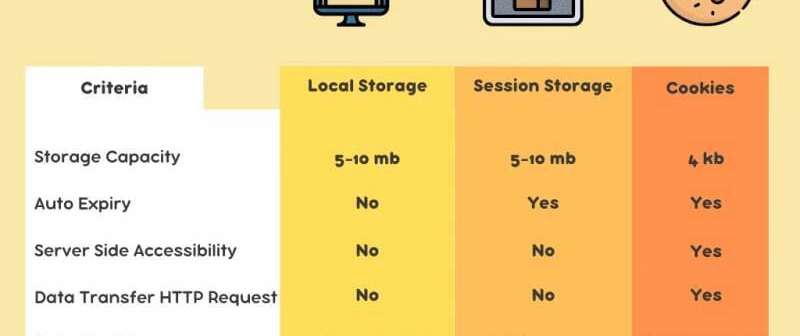When developing web applications, storing data in the browser is essential for maintaining user sessions, saving preferences, and improving performance. Three common methods for client-side storage are Local Storage, Session Storage, and Cookies. While they serve similar purposes, they differ in data persistence, size limits, and accessibility.
This article will explore the differences, advantages, and best use cases for each storage method.
1. Local Storage 🗄️
✅ What is Local Storage?
Local Storage is a browser-based storage mechanism that allows web applications to store key-value data persistently on the user’s device. The stored data does not expire and remains available even after users close and reopen the browser.
🔹 Key Features of Local Storage:
✔️ Persistent Data — Data is stored permanently until manually deleted
✔️ Large Storage Limit — Can store up to 5MB — 10MB of data per domain
✔️ Key-Value Storage — Stores data as simple key-value pairs
✔️ Accessible via JavaScript — Data can be retrieved and modified using JavaScript
✔️ Not Sent to the Server — Data remains only in the browser
📌 Example Usage of Local Storage
// Storing data in Local Storage
localStorage.setItem("username", "JohnDoe");
// Retrieving data from Local Storage
let user = localStorage.getItem("username");
console.log(user); // Output: JohnDoe
// Removing data from Local Storage
localStorage.removeItem("username");
🔥 Best Use Cases for Local Storage:
- Storing user preferences (e.g., dark mode, language settings)
- Caching API responses for offline use
- Saving progress in a web game or form
2. Session Storage ⏳
✅ What is Session Storage?
Session Storage is similar to Local Storage but with one key difference: Data is stored temporarily and is deleted when the user closes the browser tab or window.
🔹 Key Features of Session Storage:
✔️ Temporary Storage — Data is only available for the current session
✔️ Storage Limit — Similar to Local Storage (5MB — 10MB per domain)
✔️ Not Sent to the Server — Only accessible via the browser
✔️ Key-Value Storage — Works like Local Storage but expires on session end
📌 Example Usage of Session Storage
// Storing data in Session Storage
sessionStorage.setItem("sessionID", "ABC123");
// Retrieving data from Session Storage
let session = sessionStorage.getItem("sessionID");
console.log(session); // Output: ABC123
// Removing data from Session Storage
sessionStorage.removeItem("sessionID");
🔥 Best Use Cases for Session Storage:
- Storing temporary form data (e.g., during multi-step form submissions)
- Keeping session-specific user preferences
- Storing shopping cart items for a session
3. Cookies 🍪
✅ What are Cookies?
Cookies are small pieces of data stored in the browser and sent to the server with each HTTP request. They are primarily used for user authentication, tracking, and session management.
🔹 Key Features of Cookies:
✔️ Limited Storage — Maximum 4KB per cookie
✔️ Data Sent to the Server — Included in every HTTP request
✔️ Can Have Expiry Dates — Persistent or session-based cookies
✔️ Supports Secure Storage — Can be made HTTP-only and Secure
📌 Example Usage of Cookies
// Creating a cookie
document.cookie = "username=JohnDoe; expires=Fri, 31 Dec 2025 23:59:59 GMT; path=/";
// Reading cookies
console.log(document.cookie); // Output: username=JohnDoe
// Deleting a cookie (by setting an expired date)
document.cookie = "username=JohnDoe; expires=Thu, 01 Jan 1970 00:00:00 UTC; path=/";
🔥 Best Use Cases for Cookies:
- User authentication (e.g., storing login tokens)
- Tracking user behaviour for analytics
- Storing shopping cart data across browser sessions
Comparison Table: Local Storage vs Session Storage vs Cookies
Which One Should You Use? 🤔
✅ Use Local Storage if you need to store data permanently and don’t want to send it to the server (e.g., user preferences, cached API data).
✅ Use Session Storage if you need temporary data storage that should disappear after the session ends (e.g., form progress, shopping carts).
✅ Use Cookies if you need to send data to the server with each request, such as for authentication, user tracking, or session management.
Final Thoughts
Understanding the differences between Local Storage, Session Storage, and Cookies is essential for choosing the right client-side storage method for your web application.
Each method has its strengths and use cases, and using the right one can significantly improve performance, security, and user experience.
Thank you for reading! Feel free to connect with me on LinkedIn or GitHub.





Top comments (0)